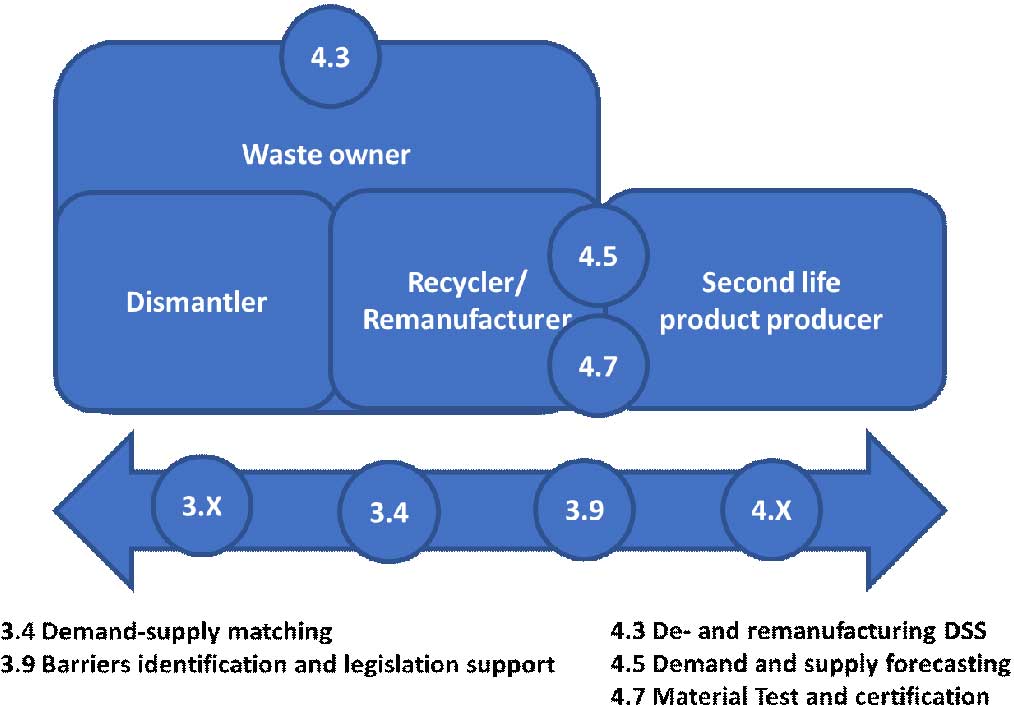The objective of this pilot is to demonstrate the fundamental role of the DigiPrime platform to support the creation of a robust circular economy for textile-made components through a cross-sectorial approach between automotive (especially for interior trim) and other textile sectors (e.g., furniture, technical textiles, etc.). Currently, a large part of textile components is not removed from end-of-life vehicles before their demolition, so it ends in the automotive shredded residue (ASR) with a consequent loss in its potential valorisation. To improve textile materials circularity, the pilot aims to fulfil the information gap between the different actors and steps of the textile supply chain in automotive and other sectors.
Textile
Problem description
Challenges
Textiles are essential parts of automobiles and other vehicles as they provide a warm and soft touch to surfaces but they also are components of the more functional parts of vehicles. Traditional use of textiles in automotive includes interior fabrics, seat upholstery, carpets, and headliners but textiles are also used to realise tire cord, fuel filters, safety belts, heater hoses, battery separators, break and clutch linings, gaskets, air bags and as reinforcement for composites. Automotive textiles have an estimated lifetime that is the same as that of the vehicle (12 years) and at the end of the vehicle life, textiles are not usually dismounted and removed but they become part of the automotive shredded residue. This current practice comes from the lack of specific and consolidate information (data, procedures, best practices) about dismounting and removal of textile parts, about verification of their quality and performance and about how to remanufacture or recycle them to create new products. By implementing DigiPrime approach (using platform’s services), Textile Pilot will demonstrate the possibility to create a virtuous circular system for textile reuse/recycle/remanufacturing between automotive and other sectors.
Overall approach
Considering the large amount of different textile and textile-based materials that come from automotive sector (over 15-20 different kinds of fabric are used in automobiles), specific categories are considered for the pilot preliminary evaluation: seat upholstery and padding, carpets, headliners, safety belts and air bags.
The overall approach of this pilot is to reduce the information gap among textile industries, automotive industries, and other possible production sectors. This aim will be reached through specific activities:
- to identify specific composition of the main automotive textile waste (ATW) coming from vehicles dismantled at their end-of-life;
- to characterise ATW in terms of compositions and properties (mechanical, chemical, ecological, etc.);
- to define and test ATW dismantling procedures and subsequent material separation and sorting;
- to define and test recovery, reuse and recycle practices for ATW;
- to select and validate cross-sectoral applications for ATW.
Use-cases and involved sectors
Use-case 1
CE Strategy: Remanufacturing/recycling
Input Sector: Automotive
Output Sector: Other Textile Sectors
Use-case 2
CE Strategy: Remanufacturing/recycling
Input Sector: Other Textile Sectors
Output Sector: Automotive
Use-case 3
CE Strategy: Remanufacturing/recycling
Input Sector: Automotive
Output Sector: Automotive
Use-case 4
CE Strategy: Remanufacturing/recycling
Input Sector: Other Textile Sectors
Output Sector: Other Textile Sectors
Involved DigiPrime services
The most relevant value-chain oriented services for Textile Pilot aim to:
- trigger demand-supply matching to monitor the flow of necessary materials in terms of what is available on and what is requested by the market;
- identify potential barriers identification and get legislation support to know and deal with the correct legislation thus implementing an effective circular business.
The most relevant operational services for Textile Pilot aim to:
- identify the best way for de-manufacturing and remanufacturing of textile components to implement the most effective solution for their re-use or recycle;
- support the procedures to test and certificate textile materials with the aim to verify their performance and their compliance with markets requirements.
Detailed description of the approach
The knowledge of automotive textiles material coming from end-of-life vehicle (in terms of properties, residual performances and technical specifications) will be fundamental to understand how valorise them through the best recycling/remanufacturing approach. Since specific and consolidated dismounting and recovery practices for automotive textiles are not currently available, during the Pilot will be necessary define and validate them and also to verify potential barriers for introducing textile materials (that are usually considered as low value waste) in a circular economy model. Identification of the best potential second life scenarios for automotive textile materials will be a key aspect and will be made on the base of materials characteristics and of markets needs and availability.


This project has received funding from the European Union’s Horizon 2020 Framework Programme, DT-ICT-07-2018-2019 “Digital Manufacturing Platforms for Connected Smart Factories” topic, under Grant Agreement ID 873111
